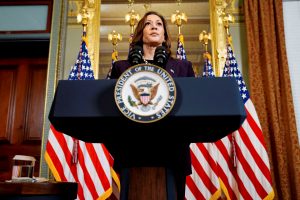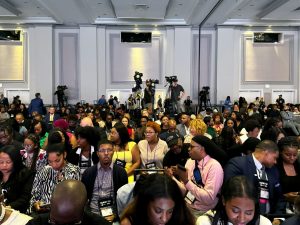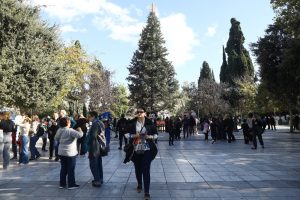In the final weeks before Election Day, the campaigns have targeted their fight for votes to particular racial and ethnic groups, with Vice President Kamala Harris rolling out an “opportunity agenda for Black men” and Donald Trump courting Latino voters in a town hall hosted by Univision in the past week.
Yet increasingly, the categories familiar to recent generations—white, Black, Asian, Native American, Native Hawaiian and Hispanic—are dissolving rapidly, yielding to more fluid and complex identities that researchers and politicians are struggling to understand.
By one definition, the U.S. multiracial population surged from nine million to almost 34 million from 2010 to 2020, or from about 3% to more than 10% of the population, according to the Census Bureau.
Vice President Kamala Harris’s own mixed-race background has repeatedly come up since her Democratic nomination. Trump asked at the National Association of Black Journalists’ annual convention in July, “So I don’t know, is she Indian, or is she Black?” and earlier this week he said that “a lot of people didn’t know” she was Black. Harris, who for years has publicly identified as Black American and South Asian American, has said in this campaign that incessant talk of racial divisions is bad for the country.
“At the end of the day, it doesn’t matter to President Trump how Kamala Harris chooses to identify herself today, yesterday, or tomorrow,” a Trump spokesperson said.
As racial categories blur, factors such as education levels, class, religion and geography are rising in voter salience, say political scientists.
A host of developments has propelled the transformation: census-processing shifts; changing family makeups; accelerated immigration from Asia, Africa and the Americas; ancestry research; and intensifying demand for government statistics to document more about each person.
Georgia Republican activist Marisa Sanchez DeRossett embodies America’s evolving demographics. Born to a Mexican-American father and white mother, she had three children by two men, one of whom she married. One of her children identifies as Afro-Latino, one as Black and one as Hispanic, she said. Now 50, Sanchez DeRossett is married to a white woman. Both political parties, she contended, fail to grasp America’s growing complexity and race’s diminishing prominence.
“We’re just going to get to the point where we’re like Brazil, where everybody is a little bit of everything, and what does it matter?” added Sanchez DeRossett, who heads Nuestra Georgia, a conservative group reaching out to the Hispanic community and backing Trump’s election.
Michael Chrzan, a 31-year-old Detroit native and data-science graduate student with a white mother and a Black father, said Americans now want a more nuanced approach to race and ethnicity from political leaders.
“The way we have categorized people, it’s not working,” said the self-described progressive. “My hope is it’s going to become more about specific policies than about appealing to specific groups because you are never going to get the groups right anymore.”
More changes are coming on Census forms and in other forms of government data that will capture even more diversity. This dramatic reshaping of how people identify has profound implications for politics, society and how people think and talk about “race” in America.
The traditional “white-only” racial category will shrink in coming years, as people reclassify themselves and intermarry, said William Frey , demographer and senior fellow at the Brookings Institution in Washington. Political parties that rely on conventional racial identities to move voters will have to rethink their strategies, Frey said.
“It’s a country that is not the ’50s anymore,” he added. “All racial categories will become a little more blended, especially for people who call themselves white only.”
‘More than one thing’
Americans increasingly have a fluid view of themselves. A landmark study published in 2014 estimated that more than 8% of all Americans changed how they categorized themselves by race or ethnicity between the 2000 and 2010 censuses.
“People identify as both single race and multiple race,” said Carolyn Liebler, a sociology professor at the University of Minnesota and one of the study’s authors, along with U.S. Census researchers. “Barack Obama is Black, he’s also Black and white and it’s OK that he’s both.”
Research shows that mixed-race adolescents are four times more likely to change their racial identity on government forms than to identify consistently.
Whether multiracial voters will align more with Republicans or Democrats isn’t clear. Gender and socioeconomic status are among the strongest predictors of how people of mixed race opt to identify themselves, and how they identify could indicate their political affiliation, according to Lauren Davenport, an associate professor at Stanford.
As more multiracial voters enter the mix, further context around their identity—such as where they are from and their education level—will wield a stronger influence on political affiliation, said Stephen Ansolabehere, a Harvard University government professor who runs the Cooperative Election Study, a national survey of more than 50,000 people.
Donnis Collins, a 40-year-old Atlanta resident and self-described independent voter, first encountered a form inquiring about her race in high school. Her teacher insisted she could only select one option. That perplexed Collins, whose mother is Black and whose father was Black, white and Native American. Collins shaded half a bubble for Black and half a bubble for white—but her teacher scolded her, warning that this response would render the form unusable.
“I was more than one thing, even if I told people, ‘I’m only one thing,’” she said.
Today, the idea of declaring more than one race or ethnicity elicits far more acceptance, said Collins. She runs an Instagram account called “Mixed Girl Problems.” With more than 32,000 followers, it spotlights mixed-race celebrities and political discussions.
For Collins, Harris’s candidacy—as the first biracial woman and the first with Indian ancestry to run for president—heralds a pivotal moment for multiracial Americans. She plans to vote for Harris in November.
Some conservative biracial voters see Trump’s candidacy as opening a door to diminished identity politics. This shift would benefit multiracial Americans weary of being boxed into categories that don’t fit them, according to Camille Solberg, a former Trump White House staffer on faith issues, now working for the conservative Georgia Public Policy Foundation. Solberg is Puerto Rican and married to a white man from Wisconsin.
The couple’s four children are politically conservative and embrace the two cultures of their parents, she said: “They are Americans but they have two heritages.”
How we got here
Despite social taboos and legal barriers, Europeans, Native Americans and enslaved Black people in America long intermingled. Alexis de Tocqueville, the French political scientist who traversed the U.S. in the 1830s, observed that in some parts of the country, “it is rare to meet with a man who is entirely black or entirely white.”
Waves of immigrants accelerated racial and ethnic blending. Irish, Italians and others once considered nonwhite “became white” over a few generations, even as barriers for Black and Asian people persisted, said Davenport at Stanford.
For generations, immigrants from different parts of the world were denied U.S. citizenship. Immigrants from some Asian countries weren’t allowed to become citizens until 1952. The Supreme Court struck down a series of racially discriminatory laws from the 1940s into the 1970s, including a 1967 decision that ended bans on interracial marriages.
The White House Office of Management and Budget—which sets statistical policy for all federal agencies—didn’t allow a multiple-race option until 1997, a change first reflected on the 2000 census. That spawned dozens of possible combinations. A separate question about Hispanic ethnicity, which had been added in 1980, further multiplied the variations because it created a Hispanic and non-Hispanic category for each race combination.
To reflect the multiple-race option, the Census Bureau implemented a new counting system alongside the old one. The old system retained single-race categories and grouped those who chose more than one race into a “two or more” category.
The new system tallied multiracial people in each category they selected. For example, someone identifying as both “white” and “Black” was counted in “white alone or in combination” and “Black alone or in combination” categories. Percentages derived from total choices, not total people. In 2020, “white alone” included 62% of the population, while “white alone or in combination” accounted for 64% of chosen identities.
In a parallel trend, genetic testing technology ballooned, allowing people to scrutinize family backgrounds more precisely: 23andMe has 15 million genotyped customers, up from 650,000 a decade earlier, and can now pinpoint data from specific regions in Africa and East Asia, the company said. Ancestry has 3.6 million subscribers, up from just over two million in 2013.
Several small changes to the 2020 census significantly magnified its assessment of American diversity. For the first time, the census allowed respondents selecting “white” or “Black” to add detail, as it had already done for other categories, including Hispanic, American Indian, Asian and Native Hawaiian. Those checking Black were prompted to specify their origins, such as African-American, Jamaican, Haitian, Nigerian, Ethiopian and Somali.
The Census Bureau also expanded its capacity to recognize and classify write-in responses, extending from 30 to 200 characters, and from two to six terms. It changed its coding rules to capture more detail in longer responses.
One striking result: a 276% jump in the multiracial population, to 34 million, between 2010 and 2020. Notably, a third of this group is under 18, according to the Census.
The future promises to unveil even more detail. In March, the Office of Management and Budget adopted its first major revision on the subject since 1997. It eliminated the requirement for a separate question about Hispanic ethnicity, instead adding “Hispanic or Latino” ethnicity to the existing list. It also introduced a category for “Middle Eastern or North African” ethnicity and required agencies to allow detailed responses to each category. The shift will trigger years of changes on official forms.
Rethinking categories
Linda Hoang, 36, previously selected “Asian” on forms that required her to choose a race. But Hoang said she intends to select “some other race” on the next census form.
Though she knows many people presume she is Asian, that category alone never resonated with her.
She grew up in a U.S. military family, living in Nebraska, New Jersey and elsewhere with a mother of Hungarian (and Irish) heritage who infused the family home with that food and culture. But Hoang’s Vietnamese father, a refugee of war, shied away from talking about where he grew up.
“My dad, because of his trauma, wanted me to be as ‘American’ as possible,” said Hoang, now an office manager for a nonprofit civil rights organization in Atlanta. As an adult, she has sought to learn more about Vietnamese culture and says her father regrets not being able to share his native language with her.
“We need to get past these rigid identities,” said Hoang, who doesn’t affiliate with one political party but is more likely to vote Democratic.
Lise Funderburg’s mother is white and her father was Black. Funderburg, 65, who wrote a book about being mixed race in America, said her fair skin and blue eyes led people to assume she was white. “I could not ever claim that identity without feeling like I was on some level betraying part of my heritage,” she said.
Today, Funderburg selects “Other” or “Black” on forms, she said. Recently, at a Nigerian-American-owned pharmacy, she noticed they had categorized her as white. She shared her DNA test results with them, showing her genetic makeup as about one-fifth Black. She jokes that now the pharmacy staff calls her “auntie,” an African term of endearment.
“Whether you can see my 19% Nigerian background or not,” Funderburg said, “I know it’s there and Ancestry.com knows it’s there.”
Chrzan, the mixed-race graduate student from Michigan, said for years he simply perceived himself as Black, because the world saw him as Black.
His undergraduate experience at the University of Michigan precipitated a change. Classes, art installations and conversations with peers made him reconsider the label “Black,” and he began to consider himself as Black culturally, but also biracial. He now detects a nationwide shift.
“Politicians have to rethink their categories,” he said. “That is where the country is moving, into subgroups and smaller subgroups, to the individual level, because that’s what we are really experiencing.”
Write to Oyin Adedoyin at oyin.adedoyin@wsj.com , Cameron McWhirter at Cameron.McWhirter@wsj.com and Paul Overberg at paul.overberg@wsj.com




